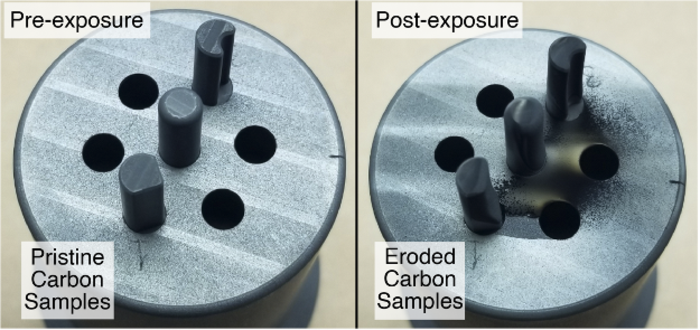Heat shields have long been used by spacecraft for protection while entering into planetary atmospheres. Missions to the outer solar system in the future will necessitate more advanced materials than currently available. The extreme heating conditions required to examine new shield materials are, however, very problematic to realize experimentally on Earth.
 This set of carbon test samples (before, left, and after, right) was exposed to hot plasma in the DIII-D tokamak. Researchers measured the ablation behavior under this extreme heat and particle flow to simulate conditions experienced by spacecraft heat shields during atmospheric entry. (Image Credit: UC San Diego Center for Energy Research).
This set of carbon test samples (before, left, and after, right) was exposed to hot plasma in the DIII-D tokamak. Researchers measured the ablation behavior under this extreme heat and particle flow to simulate conditions experienced by spacecraft heat shields during atmospheric entry. (Image Credit: UC San Diego Center for Energy Research).
In recent times, researchers working at the DIII-D National Fusion Facility at General Atomics (GA) have formulated a pioneering approach that exploits the conditions within a fusion reactor for testing heat shield materials.
During high-speed entries into planetary atmospheres of up to 100,000 miles per hour, such as those needed in missions to the Solar System’s gas giants, the atmospheric gas around the spacecraft turns into plasma (a combination of electrons and ions) and spacecraft temperatures increase to over 10,000°F.
To guard the scientific payload, the heat shield material burns (or ablates) in a well-ordered manner, which forces the excess heat away from the center of the spacecraft.
Earlier heat shield testing methods using plasma jets, lasers and hypervelocity projectiles suffered from the issue that no single technique could mimic the precise heating conditions that are encountered during a high-speed atmospheric entry.
Therefore, previous models of heat shield behavior have occasionally over- or under-predicted ablation of the heat shield, with potentially catastrophic outcomes. The experiments at DIII-D showed that the hot plasma formed by a fusion reactor during operation provides a new and possibly better way of modeling heat shield behavior, particularly for entries into Venus or the gas giants.
Certain regions of the plasma in DIII-D closely approximate the conditions created when heat shields impact planetary atmospheres at extreme velocities. Our intent with these experiments was to leverage both these conditions and DIII-D’s rich suite of diagnostic instruments to develop a more accurate model of heat shield behavior.
Dr. Dmitri Orlov, Study Lead, University of California San Diego
The majority of experiments carried out at DIII-D are meant to investigate the physics basis for fusion energy. A current system at DIII-D, called the Divertor Materials Evaluation System (DiMES), is engineered to test materials for future reactors. DiMES is designed to expose test samples to different plasma conditions as well as push pellets of test material via the plasma.
Dr. Orlov and Dr. Eva Kostadinova of Auburn University, along with a group of researchers, graduate and undergraduate students, used DiMES to analyze the ablation rates of carbon samples under extreme settings and improve predictive prototypes for carbon-based heat shield behavior.
These experiments were performed under the patronage of the Frontier Sciences program, financially backed by the U.S. Department of Energy (DOE), to offer access to DIII-D and other DOE-funded facilities to the larger physics community.
DIII-D features relatively long plasma discharges with well-controlled stable conditions at the edge, where the heat flux and the flow speed are similar to those experienced during atmospheric entries. This allowed us to simulate some of the most extreme conditions heat shields have experienced, such as the entry of the Galileo probe to Jupiter’s atmosphere, without the need to launch our test samples at high velocities.
Dr. Eva Kostadinova, Scientist, Auburn University
Since DIII-D is one of the world’s most versatile and extremely instrumented fusion reactors, the researchers were able to collect a variety of useful data on the behavior of the samples. By using scaling methods, they generalized the results to larger projectiles and extended exposures, which enabled comparison with experimental data from earlier space flight missions and other on-ground testing facilities.
The results provide significant promise to create the advanced heat shield materials essential for scheduled missions to Venus and the Jovian moons.
The research was assisted by U.S. DOE under awards DE-FC02-04ER54698, DDE- SC0021338, E-FC02-04ER54698 and DE-SC0021620.